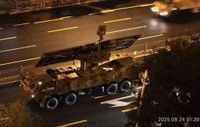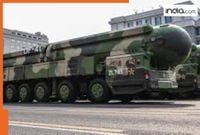In a display that has captured the world’s attention, China is set to stage its largest-ever military parade on September 3, 2025, in Beijing’s iconic Tiananmen Square. The event, marking the 80th anniversary of the end of World War II, will not only commemorate a pivotal moment in history but also serve as a showcase for the country’s rapidly advancing military technology. According to Bloomberg and Reuters, the parade will feature an impressive mix of cutting-edge weaponry, including hypersonic missiles, high-power microwave systems, advanced drones, and new armored vehicles—each a testament to China’s ambition to modernize its armed forces and assert its presence on the global stage.
Satellite imagery released in the weeks leading up to the parade has revealed a staging ground brimming with armored vehicles, air defense systems, artillery, rocket launchers, and cruise missiles. The images, analyzed by both Caliber.Az and Bloomberg, also show the imminent unveiling of China’s latest anti-ship missiles, combat drones, and nuclear-capable ballistic missiles. These developments signal not just a leap in military capability, but also a strategic message to potential adversaries and international arms buyers. China, already the world’s fourth-largest arms exporter, is keen to attract the attention of developing nations—most notably Pakistan, a frequent customer of Chinese defense hardware.
One of the parade’s headline attractions will be the debut of three new high-power microwave weapon systems, as reported by Defence Blog. Mounted on massive Shacman SX2400/2500 series 8×8 trucks, these directed energy weapons are designed to counter the ever-growing threat of unmanned aerial vehicles by disrupting or destroying their electronics with focused bursts of microwave energy. The systems, equipped with large planar antenna arrays and radar units, promise the ability to engage multiple drone targets quickly and at a lower cost per shot compared to conventional air defense. The appearance of at least three such vehicles during rehearsals signals China’s production capability and confidence in the technology—a clear nod to similar U.S. efforts, like Raytheon’s CHIMERA and Epirus’s Leonidas platforms.
But the technological marvels on display don’t stop there. Analysts expect to see a wide range of hypersonic anti-ship missiles, supersonic cruise missiles, and new tanks and infantry vehicles equipped with advanced sensors and active protection systems. The DF-41 intercontinental ballistic missile, capable of reaching targets in the United States, is also expected to make an appearance, as recent satellite images suggest. Defense analyst Rick Joe, quoted by Caliber.Az, highlighted the variety of new missiles set to be unveiled: “Various new missiles (ship UVLS launch?) confirmed, my 2c on roles: YJ-15, ramjet compact supersonic? YJ-17, waverider hypersonic glide? YJ-19, maybe scramjet hypersonic? YJ-20, biconical hypersonic/aeroballistic? Possibly seen before from 055.”
China’s investment in hypersonic technologies is particularly noteworthy. As Tianran Xu, a senior analyst at a security think tank, told Bloomberg, “The new People’s Liberation Army weapons incorporate cutting-edge technology such as hypersonic systems to increase the chances of defeating shipborne air defense systems, and are clearly developed with the aim to suppress the US Navy in the Western Pacific.” Xu emphasized that the focus on precision strike and unmanned capabilities reflects China’s goal “to win a high-tech, high-intensity war.” Few other nations, he noted, have developed such a broad array of anti-ship missiles for every conceivable scenario.
Among the more eye-catching additions to the parade will be advanced drones, including so-called “faithful winged companion” systems designed to operate alongside manned fighter jets. These drones, visible in satellite images and online leaks, are part of a broader push to multiply the capabilities of traditional weapons, sensors, and electronic warfare platforms. The Feihong FH-97 stealth drone, first unveiled in 2021, is expected to make a prominent appearance, signaling China’s commitment to integrating unmanned systems into its air force. Such efforts mirror American investments in collaborative combat aircraft, highlighting the intensifying technological rivalry between the two superpowers.
The parade will also feature the KJ-600 early warning plane, capable of operating from China’s aircraft carriers—a crucial step in the country’s quest for blue-water naval capability. The medium-sized ZTZ-201 tank, bristling with what analysts believe are advanced sensors and battle management systems, will roll through Tiananmen Square as well. Perhaps most intriguing is the debut of a torpedo-shaped sea drone, too large to be launched from conventional submarines, which analysts suggest may already be in service or close to operational deployment. According to Ben Lewis, founder of the open-source platform PLATracker, “If they can produce a lot of these kinds of weapons cheaply, things could get very ugly, very fast in a Taiwan scenario.”
Yet, for all the spectacle, questions remain about the real-world effectiveness of China’s military modernization. As Reuters reports, some experts caution that the parade is as much a performative display as it is a demonstration of capability. Drew Thompson, a senior fellow at Singapore’s S. Rajaratnam School of International Studies, remarked, “It is performative but it doesn’t speak to capability, and we still don’t know how effectively China could tie it all together and operate in a conflict scenario.” The People’s Liberation Army has not been tested in combat since a border conflict with Vietnam in 1979, leaving analysts to wonder how well these advanced systems would function in the chaos of a real war.
Still, the message China intends to send is clear. The parade takes place against a backdrop of heightened tensions in East Asia, with increased Chinese military activity around Taiwan and the disputed South China Sea. China has repeatedly asserted its claim over Taiwan and has not ruled out the use of force to achieve reunification—a stance that has drawn strong objections from Taiwan’s President Lai Ching-te and his government. The event also follows a summit in Tianjin, where President Xi Jinping is expected to meet with Russian President Vladimir Putin, Indian Prime Minister Narendra Modi, and other world leaders, underlining the parade’s diplomatic significance.
China’s defense ministry has framed the event as a demonstration of the military’s adaptability and readiness for future wars. Parade deputy director Wu Zeke stated last week, “The weapons and equipment will fully demonstrate our military’s robust ability to adapt to technological advancements, evolving warfare patterns, and win future wars.” With regional military attaches and security analysts scrutinizing every detail, the parade is set to be a defining moment in China’s ongoing quest for military modernization and strategic influence.
As the world watches the spectacle unfold in Beijing, the true test of China’s new arsenal may lie not in the grandeur of the parade, but in its ability to translate technological prowess into real-world capability and strategic advantage.



